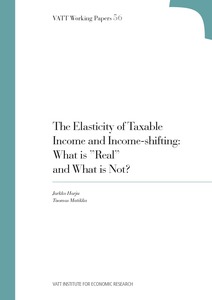The Elasticity of Taxable Income and Income-shifting: What is "Real" and What is Not?
Harju, Jarkko; Matikka, Tuomas (2014-09-11)
Harju, Jarkko
Matikka, Tuomas
Valtion taloudellinen tutkimuskeskus VATT
11.09.2014
All rights reserved
Julkaisun pysyvä osoite on
https://urn.fi/URN:ISBN:978-952-274-115-8
https://urn.fi/URN:ISBN:978-952-274-115-8
Tiivistelmä
Previous literature shows that income taxation significantly affects the behavior of high-income earners and business owners. However, it is still unclear how much of the response is due to changes in effort and other real economic activity, and how much is caused by tax avoidance and tax evasion. This distinction is important because it affects the welfare implications and policy recommendations. In this paper we distinguish between real responses and tax-motivated income-shifting between tax bases. We show how the explicit inclusion of income-shifting affects the welfare analysis of income taxation. In our empirical example we find that income-shifting accounts for over two thirds of the overall elasticity of taxable dividend income among Finnish business owners. The large income-shifting response significantly decreases the marginal excess burden compared to the standard model in which the overall elasticity defines the welfare loss. However, in addition to income-shifting, we find that dividend taxation significantly affects the real behavior of owners.
11.9.2014 released WP was reissued 17.9.2015
11.9.2014 released WP was reissued 17.9.2015
Tutkimusteema
Taxation and Social Transfers, Julkisen talouden rahoitus ja tulonsiirrot
JEL
H240 - Personal Income and Other Nonbusiness Taxes and Subsidies; includes inheritance and gift taxes, H250 - Business Taxes and Subsidies including sales and value-added (VAT), H320 - Fiscal Policies and Behavior of Economic Agents: Firm
Avainsanat
Elasticity of taxable income, Tax avoidance, Income-shifting, Real responses
Kokoelmat
- VATT Working Papers [164]
